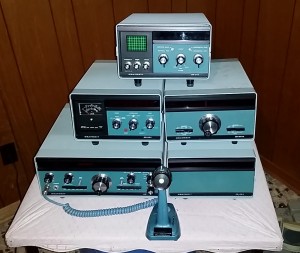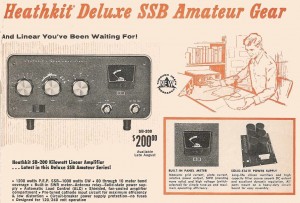Introduction
High Frequency, HF, is the bread and butter of any amateur radio operator. Surfing through the airwaves, pulling in remote and faint signals bouncing sky-to-earth and back who knows how many times is what most people think of when they think of ham radio. It probably goes without saying that HF would be adopted as the first child of “The VA1DER Project“. HF is the magic of ham radio. The romance. The coolness factor. It’s my nerd “first love”. As other technologies come and go, I may for a time leave HF, but I’ll never leave it alone.
The project name, “Huff”, is a tribute to the unsung hero technology of World War II, the High Frequency Direction Finder, or “Huff Duff“.
Mission:
Learn and explore the science and technologies surrounding high-frequency signal propagation and communications and to use these technologies to develop and maintain international acquaintances and contacts.
The parent project’s mission which we must adhere to here as well, is to: Explore the science and technology of radio and communications with special regard to those technologies offering the widest range and scope of communications with the lowest requirement for intermediate infrastructure.
Methodology:
The mission is to learn and explore HF – the science of it, the technology of it, and to communicate with it. This is likely to be an ongoing project with a lifetime that matches the lifetime of my amateur career. I can’t predict now where it’s going to go in the future, but common sense (and the inherited parent project’s mission) dictates that to start I put together a station that meets the following criteria:
- Relatively general purpose radio equipment.
- The mission is first and foremost to learn, so the equipment has to be stuff I can tinker with. In fact, maybe even equipment I have to tinker with – stuff that needs some refurbishment. Not so much that I’m buying a problem, but enough that I learn how it all works.
- One antenna to start – so one that’s multi-band. I’ll likely spawn this off into its own child project.
- Not trailer-trash stuff. I want something to start, but also something I can be proud to show off.
Current Status:
Most of my progress towards getting an HF shack outfitted actually dates from before I developed my project methodology. I made a bunch of purchases about two years ago, shortly after I got my license. They were ad-hoc purchases made in the glow of having just got my license made perhaps more by by emotion and spur-of-the-moment intuition than by calm deliberation. However, as I wrote considered the methodology section above and really thought about the type of equipment I need, I realize that my intuition at the time was pretty darn good. I can’t rule out that what I wrote was influenced by what I had already purchased, but by and large I was happy then with the gear I found, and having spent some time deliberating, I’m still happy with it. I was also pretty lucky. Here is a list of my current gear:
- Heathkit SB-104A HF SSB Tranceiver
- Heathkit SB-604A Speaker with HP-1144 power supply
- Heathkit SB-614 Monitor Scope
- Heathkit SB-634 Station Console
- Heathkit SB-644 Remote VFO
- Heathkit SB-200 SSB Linear Amplifier
- MFJ MFJ-993 IntelliTuner Antenna Tuner
- Turner SSB+2 Microphone
I’ll note the antenna tuner – this was calculated based on my knowledge that my initial antenna was going to necessarily have to be multi-band. And a single antenna that works on multiple bands is, almost always, great on none of them.

My beloved Heathkit series 2 (SB-104) family pieces. From top to bottom: SB-614 Scope, SB-634 Station Console, SB-644 VFO, SB-104a Transceiver, SB-604 Speaker w/ Power Supply
I chose most of my initial gear from the Heathkit group 2 HF line. This is the second sideband series that Heathkit introduced in 1974. It was their first all-solid-state offering, and in addition to being (hands down) the best looking matched set of HF gear I’ve ever seen (no trailer trash for me), it also was… is… some of the finest gear to learn on and use ever made. I have been lucky enough to put together an almost complete set. The only item I’m missing from the set is the matching linear amplifier, the SB-230. This was actually a purposeful omission – the SB-230 uses a tube final that is well and truly out-of-production (Eimac 8873) on a beryllium oxide ceramic heatsink that is carcinogenic. I fully intent to get one in the future, but at this stage I didn’t want to start with a unit that needed a tube retrofit right out of the gate which might require hazmat gear. So, instead, I decided to start with the earlier, and almost legendary SB-200 linear amplifier.
Actually, not almost. This really is a legendary unit. It was introduced in 1964 and produced for 20 years. The tube this amplifier uses, the venerable 572B, isn’t the best. It has long leads and internal capacitance that makes it a little on the unstable side for VHF osculations. But it does have the benefit, though, of being a tube that remains in production today. That in and of itself says a lot since this amplifier (and it’s Ameritron derivatives) are pretty much the sole users of this tube. The amplifier itself is, for the most part, very well designed and readily upgraded and experimented with. In short, it is the perfect platform to learn on.
Lessons Learned:
For the person following in my footsteps, here is a list of recommendations based on what I’ve learned so far. I will update this as the project progresses.
- You will notice that almost all my gear is Heathkit. I cannot stress enough how excellent this gear is to learn on. It’s probably not a bad thing that Heathkit doesn’t exist today, since for someone as new as I am starting out, actually building a Heathkit transceiver is likely to be daunting and dangerous and I know that the allure of trying would be hard to suppress.
- If you do buy Heathkit gear to start and learn on, make sure it is working gear. Actually this goes for any gear. There is an awful lot of ham gear advertised like this: “Was my father’s (slash Uncle slash Grandfather), worked great when last used, I spent many a night watching him operate it, but I don’t have the ability to test it now so it’s being sold as is”. Ya. Stay away from that! It’s tempting to think, oh, the guy just isn’t an operator and doesn’t know how to work it and that you’re getting a deal. Don’t believe it. Most of the time they know precisely what the state of the gear is. I mean, getting gear that has some issues is fine. But make sure that overall it works. Here are links to saved E-Bay ads for my transceiver and amplifier and you’ll see what I mean:
Heathkit-SB-104A-Transceiver-Working-Vintage-HAM-Radio
Heathkit-SB-200-Linear-Amplfier
You’ll notice the amplifier’s output is down a little on 15m and the transceiver on 80m with a minor power switch issue, but that they both work and there was photographic evidence to that effect. I paid a premium for that – anything listed as tested where the sellers are willing to sticking their necks out to say it works will cost more as people will bid it up. But at this stage it’s worth it. - Read, read, and read some more about the item before you buy it. If it’s Heathkit, grab the construction manual and go over it. Almost any piece of kit will have a myriad of web sites you’ll find that talk about it. Get the ins and outs. Understand the warts.
- Strictly speaking, the linear amplifier wasn’t required to meet the initial project goals. You don’t need an amplifier as a beginner – that’s the general consensus. Which is why I’m glad I bought mine before I got all formal about the project because if I had to do it again today, meaning if I had started with the project definition before buying my gear, I probably would have talked myself out of buying it. The reason I’m glad I got it, is that it’s turned out to be very educational. It’s a simpler circuit than a transceiver, learning about tubes and the power supply circuit has been fun and writing up the refurbishment project is one of the first ways I have felt like I’m actually contributing to the general body of knowledge. In fact, what I’ve learned refurbishing it pretty much single handedly taught me what I needed to know for my advanced license.
- If you’re buying on E-Bay snipe the crap out of it. Do not bit it up during the normal time frame. Give other people no idea of your intention to buy.
- Have fun! Don’t be in too much of a hurry – enjoy the journey. I am!
Child Projects
The maintenance and refurbishment of each major item obtained in this project will eventually each have their own sub-project and in time I will have pages for each item. To date, official child projects are:
- Project “Archie” – The SB-200 Refurbishment Project
- Project “Suspense” – The General Purpose HF Antenna Project

